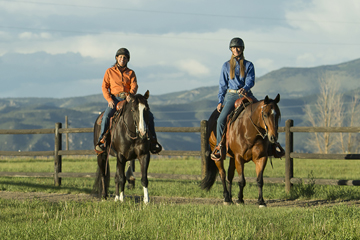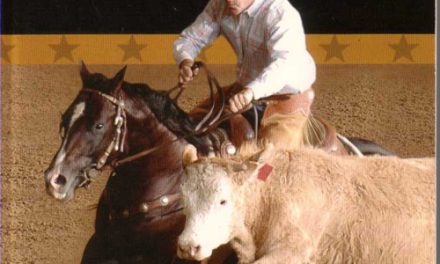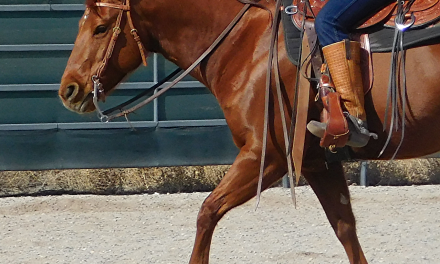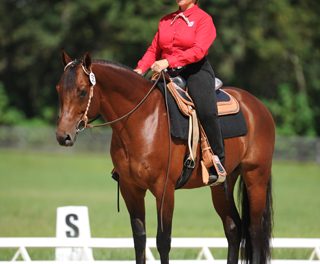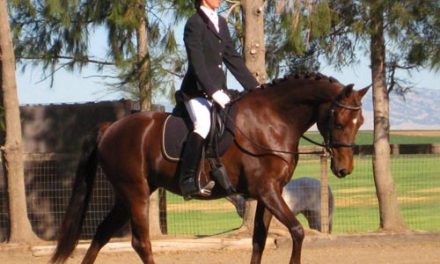 When I was a kid, horses and ballet lessons were the only non-school activities I did. I went to the barn every single day to ride my horse. Life was uncomplicated then and time was on my side; carving out time to spend with my horse wasn’t a problem. That sure has changed–you grow up and life fills in all your free time if you allow it.
When I was a kid, horses and ballet lessons were the only non-school activities I did. I went to the barn every single day to ride my horse. Life was uncomplicated then and time was on my side; carving out time to spend with my horse wasn’t a problem. That sure has changed–you grow up and life fills in all your free time if you allow it.
You’d think being in the horse profession, finding time to ride my own horses would be easy. But did you ever hear of the cobbler’s children going barefoot? Like most adults, the demands on my daily schedule are intense; between family, work, and personal commitments, my horses sometimes have to take a back seat. But quality time with my own horses is a high priority for me so I’ve made it a point to organize my life in such a way to make it happen.
As I work with the riders enrolled in my Interactive online study program, I hear a lot of frustration over how much time they have to be with their horse. When you join the program, one of the first tasks is to fill out a personal profile, which tells me about your time commitment, your experience, your horse’s level of training and your dreams. Putting all of those things together to come up with goals and a workable plan to achieve them is indeed a challenge!
Setting realistic goals with your horse, making the commitment of time and energy, getting organized and efficient with your precious time and planning ahead will make amazing things possible, even when you are short of time.
Make an Appointment with Yourself
Scrutinize your schedule and analyze your lifestyle and make a standing appointment to meet with your horse. Even if you can only commit one hour, one day a week, commit to it and make it a priority in your life. “I don’t have time,” is one of the most lame excuses ever made. If you want it, make it happen.
Find time in your schedule by organizing your life better, work-sharing with friends, hiring help or adjusting in other places, combining it with other projects (“I’ll do that on my way home from the barn.”). Combine your workout time with horse time by making it more of a workout (think posting without stirrup and power-grooming). Make horses a priority in your life, inform those around you of your newfound intentions and get creative!
For myself, it works best to actually schedule a specific time every day to ride and block it off my calendar. Plus I look at my schedule a week at a time, a week ahead of time, to plan out what days I will ride. I also consider the number of days I will ride over a longer period (and what days I will need my assistant to work my horses), in consideration of meeting my future goals. By committing to future events with my horses, it’s easier to find the time that I know will be required to meet the challenge.
Even if you can only realistically commit to one hour, one day a week, commit to it and plan your life around it. Then when you do find that extra hour in the week, it’s a lovely bonus and time you’ll appreciate even more.
Be Realistic
How much time is enough? What is not enough? These are important questions that relate to your riding goals, your horse’s level training and his age/temperament, not to mention your own life demands. It’s a complicated formula, but to make it work, you must be realistic. Your time commitment has to jive with your horse.
Certainly, a mature, well-trained horse requires less time than a green horse or a horse that has had bad experiences or abusive training. To maintain the training of a well-trained horse doesn’t take much time; if you are lucky enough to be in this category, riding one day a week may be enough. But to progress a horse’s level of training, let’s say from baby-green to finished (whatever your chosen discipline), requires daily work and may still take months and years to accomplish. A horse that needs remedial training to undo his past fears and challenges may require an even greater time commitment.
Horses are extremely fast learning animals, for better or for worse, and how quickly they learn the right things is entirely dependent on the skill of the handler (teaching them the wrong things takes no skill at all). Be realistic in factoring in your time commitment and your level of experience when considering the progress you can make with your horse. It’s best to have a horse that matches both your time commitment and ability level, not to mention your confidence level.
Be Organized
Whether it’s how you choose your wardrobe for the day, packing a lunch and eating on the fly, saving your phone calls for the drive to the barn, having a “go bag” packed with your riding clothes or turning your car into a mobile tack trunk, being organized and prepared to ride on a moment’s notice will give you more time with your horse. Keeping your apparel, gear and tack organized and easily accessible means more time in the saddle.
Thinking six months or a year ahead in where you would like to be with your horse will help you set goals, which in turn, will help you get better organized. With future goals in mind, you can make a road map to give you some direction and then you can plan all the small stops along the way and how much time you will need to get there.
Set Goals
Horsemanship is a journey, not a destination. No matter how hard you work at it, you will never know it all and you will never be a perfect rider. However, there is a lot to learn and thousands of skills to master; setting realistic goals to work toward, will help keep you focused in your training time.
Your horsemanship goals might range from attending one horsemanship clinic in the next year, to winning a year-end highpoint award in your saddle club, to going on an overnight trail ride, to competing on trail obstacles. Maybe your goals involve regaining enough confidence to canter your horse or being able to ride out alone on your horse or be able to haul your horse in a trailer.
Whatever the goal, be it small or large, it should be a challenge for you and your horse, yet attainable. Your goals should be well defined and easily measured so that it is abundantly clear when you have accomplished them. It’s important to look at least six months to a year in advance and assign a realistic time frame for accomplishing the goal. Horse sports are not known for instant gratification; most worthwhile things take the time to achieve. Looking ahead helps you set a course and develop a good training plan for you and your horse.
Once you’ve defined a goal, make a “project list” to outline all the smaller steps that you will need to accomplish to meet the goal. Take a blank sheet of copy paper, write your goal at the top in big, bold letters, and then list all the intermediate steps to get there, including any equipment, knowledge or skills you will have to acquire along the way. By keeping it all in one place, you can assign a reasonable time frame to your plan and check off the steps and /or add new ones as you progress.
One of the first assignments in my Interactive study program is to fill out a personal profile on you and your horse, to analyze your time commitment and ability levels for you and your horse so that we can come up with reasonable goals and a plan to get there. It’s amazing how getting this stuff in writing helps you find not only time, but also the focus needed to achieve goals that you never thought possible.
Make the Most of the Time You Have
Life happens and some days we have more time than we planned, while others we have less. Don’t let reality get you down, just roll with the punches and make the most of the time you have. If you are short of time, you are better off reducing your expectations than trying to rush and cram in too much. Rushing rarely works well with horses.
Horses don’t operate on human time; horse-time is altogether different. Horses can get very irritable when you get in a hurry and it’s far too easy to make mistakes, cut corners and do unsafe things. If you find yourself short of time, cut back your plans and do something meaningful and positive with your horse—less is often more. Do a little ground work instead of riding. Take your horse on a relaxing walk; give him some extra spa treatments—enjoy some quality time with your horse and be happy with that. Hurrying to cram in more often ends in a frustrating and aggravating way, for both you and your horse, and neither one of you will look forward to next time.
Look for products and gadgets that make your horse life easier and your time more efficient. Clean your saddle with disposable tack wipes while it’s still on your horse. Portable tack racks and grooming totes help keep you organized and keeps your stuff readily accessible. I am always on the lookout for anything that helps me be organized and more efficient with my horses.
Share chores with a friend—take turns bringing the horses in or feeding or watching the kids so you can devote more time to your horse on some days. Consider joining a riding club (or forming your own) or joining an online program like my Interactive study club, so that you have structure and goals and commitments. The social aspect will make it more fun and the structure will keep you focused and making progress.
Making time for horses in your life can be a real challenge, but the payoff can also be huge. What you gain in satisfaction, sense of accomplishment, vigorous exercise, and mental challenge is worth the effort. For many of us, having a meaningful relationship with a horse is worth a lot of sacrifice in other areas of our lives.
Getting organized, making a commitment and setting goals will make it possible to accomplish things with your horse that you never imagined, even if you have a busy life and no time to spare. Looking to the year ahead, it’s a good time to make a resolution, make a commitment to yourself and to your horse and make things happen!
What time-management tips do you have to share? Post them and tag #JGHorseTime to share your ideas on Facebook Twitter and Instagram.
—Julie Goodnight
Trainer and Clinician
###
—
About Julie Goodnight
Goodnight is the popular RFD-TV host of Horse Master airing Monday nights. Goodnight travels the USA sharing her no-nonsense horsemanship training with riders of all disciplines. Goodnight has ridden in many different saddles– she’s experienced in dressage and jumping, racing, reining, cow horse, colt-starting, and wilderness riding. Goodnight grew up on the hunter-jumper circuits in Florida, but is now at home in the West. She and her husband, Rich Moorhead, live in the mountains in Salida, Colorado. Both love versatility ranch horse competitions and riding cow-horses.
Explore her online library and many training videos at http://TV.JulieGoodnight.com; be sure to sign up for the free monthly training news at http://JulieGoodnight.com and please subscribe to the free YouTube channel at http://YouTube.com/JulieGoodnight.
Julie Goodnight takes on topics you want to know more about in her online training library—part of her ever-expanding Horse Master Academy (http://signin.JulieGoodnight.com) now with a free access membership to help you search for many training articles, videos and MP3s!
For more thoughts from Julie, watch her Horse Master TV show each week on RFD-TV or catch the show online anytime at TV.JulieGoodnight.com and please subscribe to the free YouTube channel at http://YouTube.com/juliegoodnight and find her on Instagram at http://www.Instagram.com/juliegoodnight. Check out her full list of clinics and appearances at: JulieGoodnight.com/calendar

